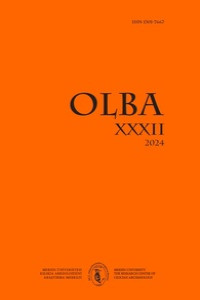Öz
Together with Procopius’ other texts; namely “Wars” and “Secret History”, “Buildin- gs” is one of the principal sources for writing the history of the reign of the emperor Justinian (527-565). “Buildings” is a panegyric and conforms to literary conventions. Procopius portrays Justinian as a powerful patron who expanded and transformed the empire, and ended the schism in Christianity by uniting the Church. The first book of Buildings is dedicated to Constantinople and focuses on the churches of the imperial capital. In the second book, Procopius focuses on Mesopotamia and Syria. He starts with Dara and devotes a passage even longer than the one he wrote on Hagia Sophia in Constantinople. When he wrote Buildings, the discussions about Christology were as pressing as the wars with Persians, and Mesopotamia and Syria were the main centers of Syriac miaphysite Christianity. Procopius rarely mentions the churches in this book on the eastern frontier and he never talks about the miaphysites. Northern Mesopotamia is an important frontier and it may seem only natural that Procopius chose to focus on fortifications to depict a strong frontier. This article argues that while avoiding tackling the Christological disputes of the day, Procopius gave implicit references related to the unity of the Church by employing some literary devices and suggests that some buildings that Procopius neglected may have pointed to the divisi- on in the Church. Procopius dedicates a long section to the Church of Sts. Sergius and Bacchus in Constantinople which has been claimed was built in the Hormisdas Palace for the miaphysite refugees and compares it with the Church of Sts. Peter and Paul, which had relics of these saints received from the Pope in Rome. His narration can potentially be interpreted as a reference to the unity of the Church. While discussing Procopius’ preferences in choosing his material and treatment, this article shows the potential of analysing the many layers of his texts and reads the “Buildings” in a new light in relation to the miaphysites.
Anahtar Kelimeler
Justinian Theodora Procopius miaphysite Syriac church of Sts. Sergius and Bacchus
Kaynakça
- Bardill 2000 Bardill, J., “The Church of Sts. Sergius and Bacchus in Constantinople and the Monophysite Refugees”, DOP 54, 1-11.
- Bardill 2008 Bardill, J., “Building Materials and Techniques”, The Oxford Handbook of Byzantine Studies, (ed. E. Jeffreys – J. Haldon – R. Cormack), Oxford, 335-352.
- Bardill 2017 Bardill, J., “The Date, Dedication, and Design of Sts. Sergius and Bacchus in Constantinople”, Journal of Late Antiquity 10/1, 62-130.
- Booth 2011 Booth, P., “Orthodox and Heretic in the Early Byzantine Cult(s) of Saints Cosmas and Damian”, An Age of Saints? Power, Conflict and Dissent in Early Medieval Christianity (ed. P. Sarris – M. Dal Santo – P. Booth), Leiden, 114-128.
- Börm 2022 Börm, H., “Procopius and the East”, A Companion to Procopius of Caesarea (ed. M.Meier – F. Montinaro), Leiden, 310-336.
Öz
Prokopius’un “Yapılar” adlı kitabı, “Savaşlar” ve “Gizli Tarih” adlı eserleriyle birlik- te çağdaşı olan İmparator Iustinianus’un hüküm sürdüğü yılların (527-565) tarihini yazmak için temel kaynaklardan biridir. “Yapılar” bir ‘imparatora övgü’ (panegyrik) metnidir ve bu edebi formun kurallarına uyar. Prokopius, bu eserinde Iustinianus’u imparatorluğu genişleten, dönüştüren ve Hıristiyanlık içindeki bölünmelere son ve- rerek Kilise’yi birleştiren güçlü bir bani olarak resmeder. Prokopius, eserine başkent Konstantinopolis ile başlar ve şehirdeki kiliseler üzerinde durur. Başkentten hemen sonra Kuzey Mezopotamya ve Suriye’ye odaklanır. Dara ile başlar ve imparatorun Dara’daki faaliyetlerine Konstantinopolis’teki Ayasofya’dan daha uzun yer verir. Ku- zey Mezopotamya önemli bir sınır bölgesidir ve Perslerle savaşlar döneme damgasını vurmuştur, ancak Iustinianus döneminde bu savaşlar kadar gündemde olan başka bir konu Kristolojik tartışmalardır. Mezopotamya ve Suriye Süryani miafizit kilisesinin merkezi olmuştur. Prokopius doğu sınırına odaklandığı bölümde nadiren kilise yapıla- rına değinir ve miafizitlerden hiç bahsetmez. Güçlü bir sınır imajı çizmek için Proko- pius’un kalelere odaklanmayı seçmesinden daha doğal bir durum olamaz. Bu makale, Prokopius’un Kristolojik tartışmalara girmemekle beraber, özellikle kilisede birliğe vurgu yapan mesajları edebi oyunlarla üstü kapalı bir şekilde verdiğini iddia eder ve Prokopius’un ihmal ettiği bazı yapıların Kilise’de bölünmüşlüğe işaret edebileceği ni önerir. Prokopius, Konstantinopolis’teki Hormisdas sarayında bulunan ve miafizit Süryanilerle barış umudu ile inşa edildiği düşünülen Sergius ve Bakkhus kilisesi ile aynı avluda bulunan ve Roma’dan getirilen rölikler içeren Peter ve Paul kilisesini kar- şılaştırmaya uzun bir bölüm ayırır. Anlatma şekli kilisenin birliği konusunda imâlarda bulunduğunu düşündürür. Bu makale, Prokopius’un Kuzey Mezopotamya’yı anlat- mak için seçtiği yapıları ve bunları ele alırken yaptığı tercihleri tartışır. Bu yazarın çok katmanlı metinlerindeki potansiyeli gözler önüne sererek, “Yapılar” adlı eserini Süryani miafizit kilisesi bağlamında yeni bir bakış açısıyla okur.
Anahtar Kelimeler
Iustinianus Teodora Prokopius miafizit Süryani Aziz Sergius ve Bakkhus Kilisesi
Kaynakça
- Bardill 2000 Bardill, J., “The Church of Sts. Sergius and Bacchus in Constantinople and the Monophysite Refugees”, DOP 54, 1-11.
- Bardill 2008 Bardill, J., “Building Materials and Techniques”, The Oxford Handbook of Byzantine Studies, (ed. E. Jeffreys – J. Haldon – R. Cormack), Oxford, 335-352.
- Bardill 2017 Bardill, J., “The Date, Dedication, and Design of Sts. Sergius and Bacchus in Constantinople”, Journal of Late Antiquity 10/1, 62-130.
- Booth 2011 Booth, P., “Orthodox and Heretic in the Early Byzantine Cult(s) of Saints Cosmas and Damian”, An Age of Saints? Power, Conflict and Dissent in Early Medieval Christianity (ed. P. Sarris – M. Dal Santo – P. Booth), Leiden, 114-128.
- Börm 2022 Börm, H., “Procopius and the East”, A Companion to Procopius of Caesarea (ed. M.Meier – F. Montinaro), Leiden, 310-336.
Ayrıntılar
| Birincil Dil | İngilizce |
|---|---|
| Konular | Arkeoloji Bilimi |
| Bölüm | Makaleler |
| Yazarlar | |
| Yayımlanma Tarihi | 8 Nisan 2024 |
| Yayımlandığı Sayı | Yıl 2024 Cilt: 32 Sayı: XXXIII |


